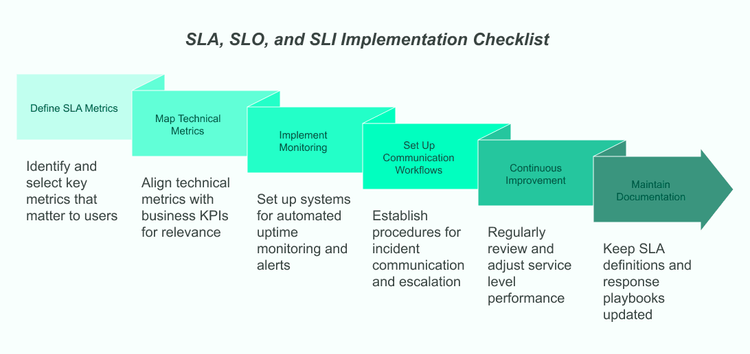Mastering SLA, SLO, and SLI: The Ultimate Guide to Ensuring High Uptime

1. Introduction
High uptime isn't just a technical goal – it's a business necessity. Modern systems need to be available around the clock, and downtime directly hits your bottom line. That's why DevOps teams and SMEs are shifting from "hope it works" to measured, monitored service level agreements.
Gone are the days of waiting for users to report issues. With the right website uptime monitor setup, you can spot and fix problems before they impact your users. But to do this effectively, you need to understand three key concepts: SLA, SLO, and SLI.
2. Understanding SLA: Its Impact on Business Performance and Reliability
An SLA (Service Level Agreement) is your promise to customers. It's a formal agreement that spells out what service level they can expect and what happens if you fall short.
Think of an SLA as an uptime contract that protects both sides. For SMEs, typical uptime contracts range from 99% to 99.9%. That might sound great, but remember: 99% uptime still means nearly 88 hours of downtime per year.
Modern uptime monitoring tools are crucial for tracking these commitments. They help you:
- Track real-time system availability through web uptime monitoring
- Measure response times with precision
- Alert you before SLA breaches occur
- Generate compliance reports for service level verification
3. Understanding SLO: Its Effects on Operational Goals
SLOs (Service Level Objectives) are your internal targets – usually tighter than your SLAs. They're the goals your team aims for to ensure you never breach your uptime contracts.
For example, if your SLA promises 99.9% uptime, your SLO might target 99.95%. This buffer gives you room to handle issues before they affect your service level agreements.
Most SMEs track these SLOs with uptime monitoring software:
- System availability through continuous monitor uptime processes
- Response time benchmarks
- Error rates across services
- Request throughput measurements
4. SLI: The Measurement Metric
SLIs (Service Level Indicators) are your actual performance numbers. They're the SLA metrics that tell you whether you're hitting your SLOs.
Common SLA metrics include:
- Percentage of successful requests
- Average response time
- Error rate per minute
- System availability percentage
Your uptime website monitoring tools should track these metrics continuously. Real-time monitoring helps catch issues early, while historical data helps spot trends that might impact your service level performance.
5. Implementation Checklist for SLAs, SLOs and SLIs
Here's your practical implementation checklist:
- Define measurable SLA metrics
- Pick metrics that matter to your users
- Make sure they're quantifiable with proper uptime detector systems
- Map technical metrics to business KPIs
- Connect uptime to revenue impact
- Link response time to user satisfaction
- Implement automated monitoring uptime and alerting
- Set up comprehensive server uptime monitoring
- Configure smart alerts through uptime tracker solutions
- Set up incident communication workflows
- Define escalation paths
- Establish response procedures for SLA violations
- Continuous improvement
- Review service level performance regularly
- Adjust thresholds based on data from your uptimer tools
- Maintain documentation and knowledge base
- Document all SLA definitions and metrics
- Keep response playbooks updated
- Review and update
- Quarterly SLA metrics reviews
- Annual uptime contract adjustments
6. Conclusion: Ensuring High Uptime with Service Levels
Service level agreements aren't just paperwork – they're your roadmap to reliable systems. Start with clear SLAs that match your business needs. Set SLOs that give you breathing room. Then track SLA metrics religiously to stay on target.
When it comes to implementation, modern uptime monitoring platforms like Bubobot make a difference. As a robust Pingdom alternative, you get:
- Comprehensive monitoring across HTTP, servers, and message brokers
- The shortest monitoring intervals in the market for near-instant service level tracking
- AI-powered anomaly detection that prevents SLA breaches
- Smart notifications that prevent alert fatigue for your DevOps team
Remember your implementation checklist:
- Define clear SLA definitions and metrics
- Set up comprehensive web uptime monitoring
- Document everything related to your uptime contracts
- Keep improving based on real performance data
The key is finding the right balance between service level agreements and monitoring capabilities. With platforms like Bubobot, you can maintain tight SLAs without overwhelming your team. That means reliable systems, satisfied users, and fewer midnight alerts.
Ready to level up your service level monitoring?
#SLA #SLI #SLO #UptimeMetrics